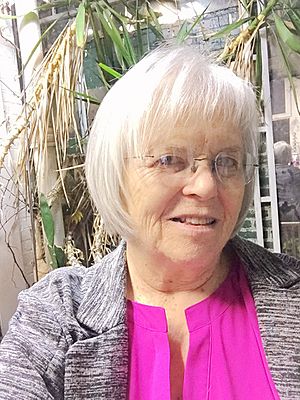Cynthia Solomon facts for kids
Quick facts for kids
Cynthia Solomon
PhD
|
|
|---|---|

Cynthia Solomon
|
|
| Born | 1938 (age 86–87) |
| Citizenship | United States |
| Education | BA, Radcliffe College, 1959 MS, Boston University, 1976 PhD, Harvard University, 1985 |
| Known for | Logo Technology education |
| Awards | NCWIT Pioneer Award, 2016 Constructionism Lifetime Achievement Award, 2016 |
| Scientific career | |
| Fields | Computer science Technology education |
| Institutions | MIT Bolt, Beranek and Newman Logo Computer Systems Atari Cambridge Research Laboratory |
Cynthia Solomon is an American computer scientist. She is famous for making computer science easier for students to learn. Cynthia is a leader in computer science and using computers for education.
While working at Massachusetts Institute of Technology (MIT), she learned a programming language called Lisp. As she learned, she realized kids needed a simpler programming language.
Cynthia also worked as a computer teacher in schools. Her work focused on how people and computers interact, and how kids can be designers. At Bolt, Beranek and Newman, she helped create Logo. This was the first programming language made for children. Logo was designed to teach programming ideas similar to Lisp.
Solomon has worked with many groups. She was a vice president at Logo Computer Systems, Inc., where they developed Apple Logo. She also directed the Atari Cambridge Research Laboratory. Later, she worked with the One Laptop per Child Foundation. She continues to share her knowledge by speaking at conferences.
Contents
Cynthia Solomon's Education Journey
Cynthia Solomon earned her first degree, a Bachelor of Arts in history, from Radcliffe College in 1959. Later, she studied at Boston University. There, she received her Master of Science degree in computer science in 1976. In 1985, she earned her Doctor of Philosophy (PhD) in education from Harvard University.
While studying, Solomon also worked as a researcher. She worked with Marvin Minsky and Seymour Papert at MIT. She also worked at Bolt, Beranek and Newman.
Key Achievements and Contributions
After college, Cynthia Solomon taught at Milton Academy for seven years. She also became the Technology Integration Coordinator at Monsignor Haddad Middle School. In the 1980s, Massachusetts Institute of Technology hired her. They wanted her to lead the Atari Cambridge Research Laboratory. This was because of her success with Logo.
Solomon has a long history with the MIT Media Lab. She also worked closely with the One Laptop per Child Foundation. She helped create educational materials for this foundation. Cynthia continues to teach, consult, and do research.
Logo: A Programming Language for Kids
In 1967, Cynthia Solomon, Seymour Papert, and Wally Feurzeig created the Logo computer programming language. This language let children try out words, solve math problems, write stories, and make their own games.
Logo is well-known for its "turtle graphics". With this, commands for movement and drawing made line pictures. These could be seen on a screen or drawn by a small robot called a turtle. In the 1970s, Logo was updated to show multiple colors. The language was designed to teach programming ideas from Lisp. Logo also helped students understand movement by imagining they were the turtle.
Helping Children Learn with Technology
Cynthia Solomon realized children needed their own programming language. This led her to develop Logo. She also guided the creation of learning materials for the One Laptop per Child Foundation.
Her research at Harvard led to a book called Computer Environments for Children: A Reflection on Theories of Learning and Education. This book looks at the good things and challenges of having computers in schools. It focuses on math in elementary schools. Solomon talks about how computers fit into new learning ideas. She also co-wrote Designing Multimedia Environments for Children with Allison Druin. She has done many other research projects and writings. These have added to our understanding of how kids learn with technology.
Solomon's later work included teaching with Snap! and jigsaw programming Turtlestich.
Writings and Publications
Cynthia Solomon has written many important books and articles. These share her research on how children learn and use technology.
- Twenty Things to Do with a Computer (1971) with Seymour Papert.
- Leading a Child to a Computer Culture (1976).
- Teaching young children to program in a LOGO turtle computer culture (1978).
- Logo Power (1984).
- Designing educational computer environment for children (1995) with Allison Druin.
- Designing Multimedia Environments for Children (1996) with Allison Druin.
- Inventive Minds, Marvin Minsky on Education (2009), which she edited with Xiao Xiao.
- Culture Audits: Supporting Organizational Success (2004).
- Select a Performance Management System (2009).
- The BBN-LISP System (1966) with Daniel Bobrow, D. L. Darley, Daniel L. Murphy, and Warren Teitelman.
- Designing multimedia environments for children (2018) with Allison Druin.
Awards and Recognition
In 2016, Cynthia Solomon received the National Center for Women & Information Technology (NCWIT) Pioneer Award. She also got a Lifetime Achievement Award at Constructionism 2016. In 2018, she gave a special lecture in memory of Seymour Papert. She also helped lead discussions about new ways to use Logo in education.
See also
 In Spanish: Cynthia Solomon para niños
In Spanish: Cynthia Solomon para niños

